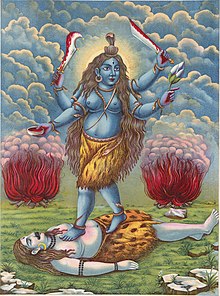Tara (Mahavidya)
This article has multiple issues. Please help improve it or discuss these issues on the talk page. (Learn how and when to remove these template messages)
|
| Tara | |
|---|---|
| Member of The Ten | |
| Planet | Jupiter |
| Weapon | Khadaga, flaying knife, skull |
| Consort | Akṣobhya Bhairava, (Shiva) |
Legends
The commonly known origin of Tara is from the 17th chapter of the
Historical origin

Tara-related beliefs are probably an amalgamation of the beliefs linked to Bhīmā or Nīlā in the geographical region of
Iconography

Tara is often described in these chapters as a fierce deity, holding kartrī (knife), khaḍga (sword), chamara (Fly-whisk) or indivara (lotus) and a single matted braid over her head. She is dark in complexion, tall, with a bulging belly, wears tiger pelts, with her left foot on the chest of a corpse and her right foot placed on a lion or between the thighs of the corpse. She has a terrifying laugh and is fearful. The goddess Tīkṣṇakāntā, who is also considered a form of Tara in the Kalika Purana, has similar iconography with dark-complexion and a single braid (ekajaṭā), and is also pot-bellied.[5]
Hindu goddess Kali and Tara are similar in appearance. They both are described as standing upon a supine corpse sometimes identified with Shiva. However, while Kali is described as black, Tara is described as blue. Both wear minimal clothing, however Tara wears a tiger-skin skirt, while Kali wears only a girdle of severed human arms. Both wear a garland of severed human heads. Both have a lolling tongue, and blood oozes from their mouths. Their appearances are so strikingly similar that it is easy to mistake one for the other. Kali is shown standing in the pratyalidha stance (in which the left foot is forward). Her Bhairava (consort) is Akshobhya, a form of Shiva who is in the form of a naga (serpent) coiled around her matted hair. She wears a crown made of 5 skulls connected with plates of bone. Eight forms of Tara are attested in the Māyātantra quoted in the tantric compendium Tantrasāra and the names are Ekajaṭa, Ugra-Tara, Mahogra, Kameshvari-Tara, Chamunda, Nila-Sarasvati (Neelasaraswati or 'Blue Saraswati'), Vajra-Tara and Bhadrakali.[8]
Scriptures
Tantric scriptures that describe the worship of Tara include Tārātantra, Brahmayāmala, Rudrayāmala, Nīlatantra/Bṛhannīlatantra, Tārātantra, Nīlasarasvatītantra as well as various tantric compendia like Tantrasara by Agamavagisha, Prāṇatoṣiṇī, Tārābhaktisudhārṇava by Narasiṃha Thakkura, or Tārārahasya by Brahmānanda Giri.[9]
Tara is mentioned in the Devi Bhagavata Purana, where it is said that her favourite place is Cīna[10] (China) and also that Svarocisha Manu worshipped the deity on the banks of the Kalindi (Yamuna).[11] She is also attested in the Kalika Purana's 61st, 79th and 80th chapter.
Modern traditions
In Bengal, the literary works of Ramprasad Sen gave a new phase to the classical secretive worship of Tara, and his devotionalism influenced the image of the deity. He addresses Tara as a daughter in his songs. Sadhak Bamakhepa also was a famous siddha of Tara in the modern era. These devotees introduced a public devotional dimension to the secretive tantric worship of this deity and emphasised her motherliness.[12]
References
- ^ Shastri, Hirananda (1998). The Origin and Cult of Tara.
- ^ Avalon, Arthur. "Shakti and Shakta". Sacred Texts.
- ^ a b Bühnemann, Gudrun. "The Goddess Mahācīnakrama-Tārā (Ugra-Tārā) in Buddhist and Hindu Tantrism". Bulletin of the School of Oriental and African Studies.
- ^ a b Pravrajika Vedantaprana, Saptahik Bartaman, Volume 28, Issue 23, Bartaman Private Ltd., 6, JBS Haldane Avenue, 700 105 (ed. 10 October 2015) p.18
- ^ ISBN 8178540215.
- ^ "Locating Mahāchīna". Sri Kamakoti Mandali. 31 March 2021. Retrieved 25 July 2021.
- ^ "Tara (Buddhist Deity) (Himalayan Art)". www.himalayanart.org. Retrieved 15 July 2021.
- OCLC 35741883.
- ISBN 8178540215.
- ^ "The Devi Bhagavatam: The Seventh Book: Chapter 38". www.sacred-texts.com. Retrieved 24 July 2021.
- ^ "The Devi Bhagavatam: The Tenth Book: Chapter 8". www.sacred-texts.com. Retrieved 24 July 2021.
- ISBN 8178540215.
Further reading
- Banerjee, Sumanta (2002). Logic in a Popular Form: Essays on Popular Religion in Bengal. ISBN 81-7046-162-6.
- Kinsley, David R. (1988). Hindu Goddesses:Visions of the Divine Feminine in the Hindu Religious Tradition. ISBN 0-520-06339-2.
- Kinsley, David R. (1997). Tantric Visions of the Divine Feminine: The Ten Mahāvidyās. New Delhi: ISBN 978-0-520-20499-7.
- MacDaniel, June (2004). Offering Flowers, Feeding Skulls: Popular Goddess Worship in West Bengal. ISBN 0-19-516790-2.
- MacDaniel, June (1989). The Madness of the Saints: Ecstatic Religion in Bengal. ISBN 0-226-55723-5.
- Shankaranarayanan, Sri (1972). The Ten Great Cosmic Powers. Dipti Publications. ISBN 81-85208-38-7.


